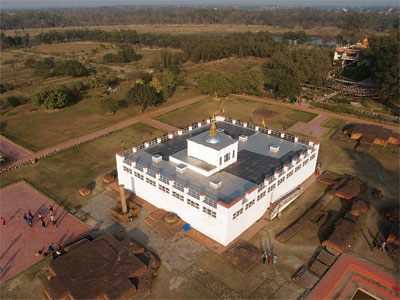On January 30, the Cultural Studies Group of Nepal (CSGN) organized its first monthly lecture of 2013 at the Shanker Hotel. The topic was alluring: Archaeological work in Lumbini, the birthplace of Buddha. Robin Coningham, Professor of Archaeology at the University of Durham, and Kosh Prasad Acharya, Nepal’s eminent field archaeologist, presented the preliminary findings from an ongoing three-year project, entitled ‘Strengthening the Conservation and Management of Lumbini, the Birthplace of Lord Buddha’. The two are co-directors of the project, which is funded by UNESCO and the Japanese government. The lecture was entitled ‘The Archaeology of the Earliest Buddhist Shrine in South Asia: Preliminary Results of Three Years of Exploration at the UNESCO World Heritage Site of Lumbini, Nepal’.
Professor Coningham started off by saying that his presentation would be about a short history of archaeology of Lumbini, including the Kenzo Tange Master Plan and development of the area. He enraptured the audience with one intriguing fact after another. During the process of excavation and investigation Coningham and his team have made discoveries that have added to all that is known hitherto about Lumbini’s history. But the finds have also challenged many long held notions about Lumbini. Coningham outlined the project’s belief by saying that Lumbini was “far more than just the Ashokan Mayadevi Temple and the garden.” The project wanted to push deeper into the past. The stress now, he said, was on “looking for evidence below Ashokan horizon [269 BCE].”
 Coningham spoke on the history as well as new discoveries made in one of Asia most important archaeological sites without ever letting the lecture become esoteric. In a conversational tone, the audience was let in on intriguing facts that are otherwise only known to the archaeologists present on the excavation site. Speaking succinctly, Coningham informed the audience not only about what had been unearthed beneath the floor of the Maya Devi Temple but also the interesting fact that the humidity in the Maya Devi Temple was increasing due to an increase in visitor numbers. If more than 500 people enter the temple in a day, Coningham told the audience, a micro climate is created inside the ancient temple, causing mould growth on monuments.
Coningham spoke on the history as well as new discoveries made in one of Asia most important archaeological sites without ever letting the lecture become esoteric. In a conversational tone, the audience was let in on intriguing facts that are otherwise only known to the archaeologists present on the excavation site. Speaking succinctly, Coningham informed the audience not only about what had been unearthed beneath the floor of the Maya Devi Temple but also the interesting fact that the humidity in the Maya Devi Temple was increasing due to an increase in visitor numbers. If more than 500 people enter the temple in a day, Coningham told the audience, a micro climate is created inside the ancient temple, causing mould growth on monuments.
It was concerns such as these that convinced UNESCO to come up with the current project. UNESCO brought together a team to work on a three-year project for the conservation and management of Lumbini. The results of the project so far have been astounding. It is now known that there was a secular village close to the Maya Devi temple dating back to 1,300 B.C. This predates the earlier dating of the site by many centuries and also reveals that the Maya Devi Temple was never isolated but part of a larger monastic and secular complex. The project has not only excavated layers but broken new ground: It is the first inter-disciplinary approach in archaeology in South Asia. The lecture undoubtedly left the audience curious for the results from the next phase of the project, which CSGN plans to bring to them through another lecture.
Established over a decade ago, the Cultural Studies Group of Nepal (CSGN) is a voluntary organization that provides opportunities for residents and visitors to learn more about the arts and diverse cultures of Nepal.
For further information, Hotel Shanker's official site is:http://www.shankerhotel.com.np










